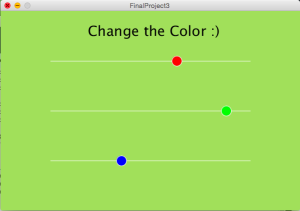I’ve been told consistently by my relatives how I need to exercise both sides of my mind: the creative right side, and the analytical left side. But instead of trying to find a blend of the two, I thought my choice stemmed between the black and white logical fields, and the colorful, ambiguous artistic world. Now I’m realizing that computational media and the interaction between art and technology is not only a new option to integrate both sides, but it’s essential to the progression of technology as a whole.
I see technology as a medium for communicating artistic ideas into an applicable format. Companies using design to improve the interaction between people understand the value of visual appeal. Art creates an experience behind engineered objects. Art communicates and transmits ideas through media, and technology adds to the functionality of this interaction. When it comes to the importance of fields like Interactive Media, I’ve found that I’m not the only student searching to infuse art into the technological world. As the technological world progresses, the demand for simplicity in technology is more and more imperative. We engineer for convenience, to enable, and to open doors for people to study and learn more about the world. The tools we use to do so demand art not only for ease in functionality, but for the communication art offers. We can use art to ask questions and consider ambiguity, and we can use art to build on opportunity in other fields.
I’d argue computational media is only in its earliest stages for the potential it has both in art and in computer engineering. But the more its fostered, the more doors I think it opens up for artists and engineers to learn skills they wouldn’t have otherwise considered. I saw a future holding a paintbrush, and I am, except I’m writing code to make a paintbrush on a computer. If nothing else, the skills learned by studying computational media can be applied to any new fields. I didn’t realize mathematicians needed to be creative, nor did I realize artists need to know how to properly manipulate sine and cosine on 3D planes to create amazing designs. It’s like we’ve just realized peanut butter and jelly work super well together.
Arguably computational media may not be considered as necessary to other computer scientists or artists as it does in my eyes. But from seeing the opportunity computational media offers me, I’m happy to lock myself away in a lab for several hours with a group of other interactive media artists. I’m happy to make amazing, beautiful, broken things in that lab, and if nothing else, I find enough intrinsic motivation to continue pursuing computational media until the world agrees with me of its importance.

